In the 1865 the South comes out destroyed by the American civil war and in the following 70 years it will remain on the fringes of the process of ascent of the United States to the rank of first world power, up to the realization of the great infrastructural works of the New Deal that will trigger its industrialization thus starting a path that will lead this regional area to become one of the most important in the world for the aeronautical and aerospace industry.
The fulcrum on which the development plan of the government led by Franklin Delano Roosevelt was set in the 30 years was constituted by the challenge of electrification of the USA that was conducted as a real military campaign dusting off the rhetoric of mobilization and the institutional instruments of the WWI.
The "electrical delay" of the rural areas and in particular of the South was indicated as the main internal enemy against which to fight if the nation was to be brought out of the Great Depression in which it had precipitated with the 29 crisis. Despite the fact that in the international comparison the United States turned out to be the most electrified country in the world, in 1930 only the 30% of American families had access to electricity and the benefits linked to a complete coverage of the supply network were the prerogative of only large urban centers .
Among the various bodies created by the Roosevelt administration, the one that achieved the most significant results was undoubtedly the Tennessee Valley Authority, established in the 1933 as a public corporation, a corporate form conceived in the 1917, during the presidency of Woodrow Wilson, to favor the management governmental armaments industry. This formula identified a company with a hybrid ownership structure, created with the aim of circumventing what was established in the Constitution and in a series of laws that forbade the state to engage as an entrepreneur in economic activities.
The achievement of the goal of a widespread electrification at the national level and which reached as far as possible in the social stratification, could not but leverage the hydroelectric potential offered by American rivers. All this in the framework of a project that as a whole aimed to fully integrate the South, both in the economic context and in the political scenario of the country.
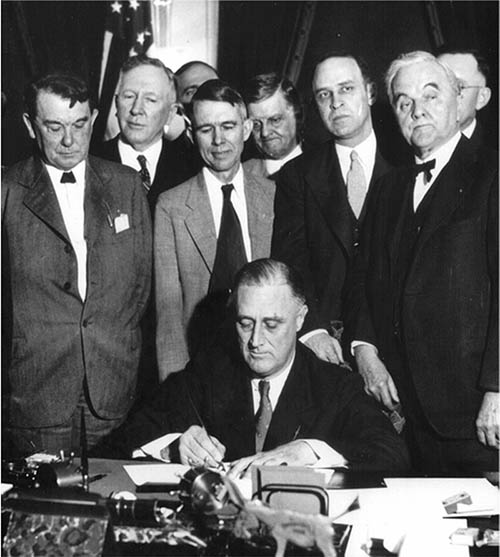
Just as the recovery of the Pontine marshes had become the centerpiece of the "integral reclamation", the TVA was the great emblem of the aspiration of the New Deal to achieve an integrated regional development. The Authority was not limited to dealing with a single sector (construction of housing, transport, agriculture or industry) but coordinated them all within a coherent strategy. [...] The dam represented a power capable of taming and civilizing, which had transformed the natural devastating power of water into usable energy, [...] It is therefore not surprising that the dam has become the central emblem of the New Deal (Wolfgang Schivelbusch "3 New Deal. Parallelisms between the United States of Roosevelt, Italy of Mussolini and Germany of Hitler, 1933-1939", Tropea Editore, 2008).
The other well-known pillar on which the industrial development of the South will rest is constituted by a subsoil rich in hydrocarbons (especially in Texas and Louisiana), as demonstrated by the discovery in 1930, near Dallas, of one of the largest deposits of gold black from the United States.
With the construction of a network of oil pipelines, the South's oil will be put in the condition to feed the industrial regions of the Midwest and North-East, developing at the same time the local industry, especially in the sectors of chemistry and mechanics (equipment for the research and extraction of hydrocarbons).
The first aeronautical installations, in the areas surrounding the cities of Dallas and Wichita (in Kansas, a little further north in the southern part of the Midwest), date back to the years' 20 and 30, but the decisive dimensional leap for this sector will come in the following decade , following the strong production increases necessary to support the US commitment in the Second World War, initially as an "arsenal of the Allies", and subsequently to the attack on Pearl Harbor (7 December 1941), with a full involvement in the war operations.
The electrification carried out with the New Deal and the start of the exploitation of oil and natural gas, had laid the foundations for the industrialization of the South but the great industry of the region was born with the mobilization of war, especially in the aeronautical sector that will see some major manufacturers transfer their plants here or open new ones.
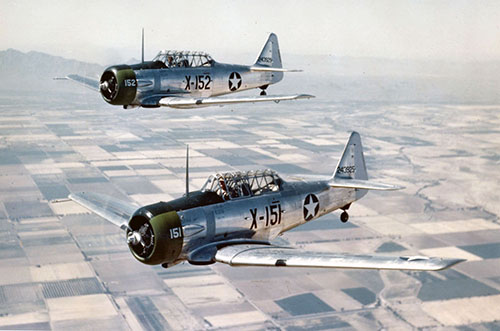 Among these is the North American Aviation which will build the AT-6 trainer (initially designated NA-16 which became T-6 after the war), baptized Texan as a new factory was built in Dallas for its production. The aircraft was presented with a metal monoplane structure with a tandem cockpit and made the first flight in April 1935 making itself immediately appreciated by the American army that ordered a first batch of exemplary 42.
Among these is the North American Aviation which will build the AT-6 trainer (initially designated NA-16 which became T-6 after the war), baptized Texan as a new factory was built in Dallas for its production. The aircraft was presented with a metal monoplane structure with a tandem cockpit and made the first flight in April 1935 making itself immediately appreciated by the American army that ordered a first batch of exemplary 42.
Production grew rapidly with the approach and then with the outbreak of World War II. The end of the conflict did not mean retirement for the Texan on the contrary, it spread internationally as it was acquired by military air forces of more than 60 countries lined up with the Western bloc. Some have used it until the 80 years and it is estimated that more than 21.000 specimens have been produced.
During the war the NAA made its own contribution to the operations of bombing and ground attack conducted by the USAAF, with the construction of the medium-light twin-engine B-25 Mitchell who went on to support the Martin B-26 in this role Marauder and the Douglas A-20 Havoc and A-26 Invader.
The B-25 was produced in various versions also for on-board use, as on the occasion of the 18 April 1942 Tokyo bombing mission, in which 16 took part in this type of aircraft which, properly lightened, took off from the USS aircraft carrier Hornet.
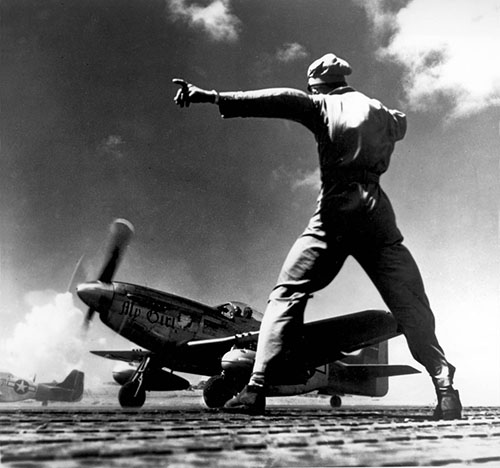 The North American also owes the most famous and best ever of US Army Air Force fighters (name adopted by the 1942 from the Air Corps, also within the army), the P-51 Mustang, designed in the spring of the 1940 to provide Britain with an effective airborne means of combating German offensives.
The North American also owes the most famous and best ever of US Army Air Force fighters (name adopted by the 1942 from the Air Corps, also within the army), the P-51 Mustang, designed in the spring of the 1940 to provide Britain with an effective airborne means of combating German offensives.
The result was an aircraft with a laminar profile wing that could boast very good performance at low altitude but tending to a noticeable deterioration as it rose. For this reason, the British have used it - since April of the 1942 - as a reconnaissance and assault, at the same time planning, together with the American manufacturer, a series of improvements.
The most advanced version, P-51D, appeared at the beginning of the 1944, equipped with a new teardrop roof (which had previously replaced the old type with a dorsal hump), and a small fuselage. The Mustang thanks to the use of two detachable subaltern tanks, it distinguished itself as an escort fighter, being able to accompany the bombers up to the targets in the heart of Germany.
Its top speed, which touched the 703 km / h, made it the fastest propeller fighter in the world with which the most skilled USAAF pilots were able to stand up to even the Messerschmitt 262, the first jet fighter of the history to be used in combat (penalized in the times and ways of its realization by a series of decisions, or rather indecision, of Hitler), of which they succeeded in destroying several specimens in some operations making use of attack tactics designed to surprise the squadrons German on the ground or taking off.
The production of Mustang it has exceeded the 15.400 specimens and has been used by more than 50 countries until the sixties, a period in which it participated in numerous post-war conflicts, including the one that affected the Korean peninsula, the 25 June 1950 broke out with the invasion of South Korea, which was a sort of American protectorate, from the pro-Soviet northern army.
 During the Korean War the November 8 - the first jet combat in history that featured the American Lockheed F-1950 (P-80 up to 80) - went on stage Shooting Star, and the Soviet MIG-15 (Bassoon, according to the conventional denomination of NATO). Despite the fact that, thanks to the superior ability of lieutenant pilot Russell Brown, he was the first to win, American military leaders realized that the models in service were not able to keep up with the MIG-15.
During the Korean War the November 8 - the first jet combat in history that featured the American Lockheed F-1950 (P-80 up to 80) - went on stage Shooting Star, and the Soviet MIG-15 (Bassoon, according to the conventional denomination of NATO). Despite the fact that, thanks to the superior ability of lieutenant pilot Russell Brown, he was the first to win, American military leaders realized that the models in service were not able to keep up with the MIG-15.
So it was decided to send on the Korean theater the most advanced aircraft among those then in force to the US Air Force (become Arma fully autonomous from the 1947), the North American F-86 Sabre, whose design origins went back to the 1944 with the NA-134 identification, referring to an experimental hunting aircraft for the navy that the US Navy renamed XFJ-1 Fury.
The prototype flight was made at the beginning of October of the 1947 and in February of the 1949 the F-86 entered service with the USAF to then be deployed in Korea from December of the 1950, with the 4th Fighter Interceptor Wing. Here the Sabre put an end to the supremacy of the MIG-15 reversing in favor of the allies (in particular of the Americans who weighed for the 93% of the air component of the forces with UN mandate), the number of victories in the fights between fighter aircraft.
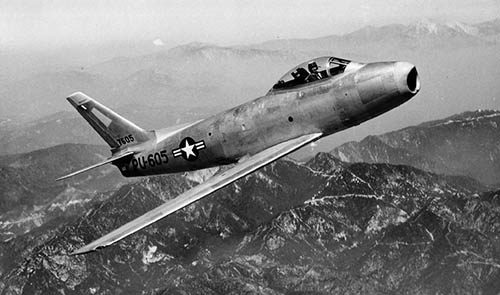 From a technical point of view, the F-86 and the MIG-15 mark the introduction of the arrow wing that allowed for a remarkable leap in quality (even though some were not lacking), compared to the previous models with straight wing. This type of modification represented one of the many practical demonstrations of the technological advantages that the USA and the USSR succeeded in realizing (at least in a shorter time), thanks to the "war booty", given that the innovative arrow wing of 35 degrees was the result of the acquisition of the advanced research carried out in this regard by technicians and engineers of Nazi Germany.
From a technical point of view, the F-86 and the MIG-15 mark the introduction of the arrow wing that allowed for a remarkable leap in quality (even though some were not lacking), compared to the previous models with straight wing. This type of modification represented one of the many practical demonstrations of the technological advantages that the USA and the USSR succeeded in realizing (at least in a shorter time), thanks to the "war booty", given that the innovative arrow wing of 35 degrees was the result of the acquisition of the advanced research carried out in this regard by technicians and engineers of Nazi Germany.
The qualities flaunted by Sabre in Korea they guaranteed its commercial success, with the realization, considering all versions and licensed productions, of approximately 9.800 specimens, with annexed use by the air forces of over 30 Countries, which in some cases kept it in service until years' 80.
The direct successor of the F-86 was the F-100 Super Saber, the first of the famous Century Series, formed by six aircraft that made their flight debut between the 1953 and the 1956. The prototype of the Super Saber it had an arrow-shaped wing of 45 degrees and was the first operational aircraft capable of overcoming Mach 1 in horizontal flight.
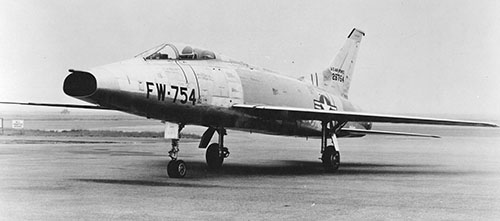 The first serial models, F-100A, arrived in the departments in September of the 1954 but following some accident caused by inertial coupling in roll, its flights were suspended for the time required by the necessary modifications. The latest version, F-100F, was used in Vietnam where it was used mainly in actions to suppress enemy air defenses. The total production of the Super Saber has touched the 2.300 units.
The first serial models, F-100A, arrived in the departments in September of the 1954 but following some accident caused by inertial coupling in roll, its flights were suspended for the time required by the necessary modifications. The latest version, F-100F, was used in Vietnam where it was used mainly in actions to suppress enemy air defenses. The total production of the Super Saber has touched the 2.300 units.
Although these are well-known models, for the record the other members of the Club of the Cento Series are: Convair F-102 Delta Dagger (first flight performed on 24 October 1953), Lockheed F-104 Starfighter (7 February 1954), McDonnell F-101 Voodoo (29 September 1954), Republic F-105 Thunderchief (22 October 1955), Convair F-106 Delta Dart (26 December 1956).
In March of the 1968 the NAA merged with the Rockwell-Standard, to form the North American Rockwell which then adopted the name of Rockwell International. In December 1996, Boeing acquired its defense and space divisions, including North American Aviation Autonetics and Rocketdyne, with the subsequent sale of the latter to UTC Pratt & Whitney (now United Technologies), in 2005.
Another illustrious name of the Texan aeronautical industry is that of the Vought of Dallas, where it moved to the 1949, upon request of the military leaders that they considered excessive, and therefore an easy target in case of war (against the USSR of course), the concentration in the east coast, of defense-related industrial plants.
 This company in the 1938 had started the project that will give birth to the F-4U Corsair, an embarked fighter whose prototype flew the 29 May 1940. This plane was the first to break the 400 barrier miles per hour (about 640 km / h), in horizontal flight, but the changes that were necessary for the first version made the use on board problematic.
This company in the 1938 had started the project that will give birth to the F-4U Corsair, an embarked fighter whose prototype flew the 29 May 1940. This plane was the first to break the 400 barrier miles per hour (about 640 km / h), in horizontal flight, but the changes that were necessary for the first version made the use on board problematic.
Thus it was initially assigned to the Marines who employed it from land bases, until in April of 1944 it was declared operational on aircraft carriers. In the different roles in which the Corsair it turned out to be excellent and it continued to be produced until 1952, for a total of about 12.500 copies.
The Vought family album includes what is considered to be the first real "supercaccia" of the American Navy, the F-8 Crusader, which carried out the first 25 March 1955 flight. In the same month of the 1957, the first series aircrafts entered service with the characteristic arrow wing with variable shrinkage which, thanks to the automatic increase in incidence, made it possible to obtain greater lift at low speeds, reducing the need for the pilot to make lift the aircraft during take-off and set-up.
 This supersonic fighter designed for air superiority activities, proved to live up to expectations during its operational use in the Vietnam War and was built throughout 1259. Among the various versions, the reconnaissance RF-8G continued to fly until the beginning of the 80 years but the record of longevity of this model goes to the Filipino air force units that will continue the activity for about another twenty years.
This supersonic fighter designed for air superiority activities, proved to live up to expectations during its operational use in the Vietnam War and was built throughout 1259. Among the various versions, the reconnaissance RF-8G continued to fly until the beginning of the 80 years but the record of longevity of this model goes to the Filipino air force units that will continue the activity for about another twenty years.
The 27 September 1965 made its debut in the skies over theA-7 Corsair II, whose version A will enter into service the following year. It was an aircraft inspired by the general lines of the Crusader but with important differences being a subsonic machine with enlarged and equipped fuselage - in particular the A-7E model - with the navigation and attack system NWDS (Navigation Weapon Delivery System), equipment which it represented the state of the art for the fighter-bombers of the time.
In the 1967 Corsair II made his appearance in Vietnam with the assignment to the VA-147 department embarked on the USS aircraft carrier Cleaning. During his activity in the Indochinese theater, the A-7 proved capable of carrying a remarkable variety and quantity of weaponry and of dropping it with precision at considerable distances. Also this aircraft was made in different versions for a plurality of uses, including training, reaching the assembled 1.526 units.
With the acquisition completed by James Ling, in the 1962, the Dallas company takes the name of Ling-Temco-Vought and after a series of changes of hands and organizational reorganization, in 2010 it becomes part of the supply group aeronautical Triumph Aerostructures, following the sale by the Carlyle fund to the Triumph Group.
Southern industrialization is a story where state interventionism and rearmament cycles have played a crucial role in the process of developing a regional area in which the combination of private initiative and public investment has always been a constant trait. This aspect is usually treated with amazement by those who are used to observing the United States from the deceptive view of liberalist ideology.
According to the standard bearers of laissez-faire, the condition of free trade in local or international trade and the spontaneous private initiative represent the rule, while state intervention in economics and protectionism would be exceptional instruments, to be tolerated at most. reluctantly, as indispensable in the (only) initial phase of a country's economic development.
Yet as Vera Zamagni points out: from a historical-comparative analysis it emerges that the first and perhaps the oldest of prejudices is that protectionism is an exception in the history of trade policies, in fact the opposite is true: liberalism is the exception and protectionism is the rule. [...] the problems produced in capitalist societies by industrialization [...] still claim other public interventions, different in their nature, but also in their relative weight, depending on whether the private initiative proves able to assume the solution of a greater or lesser part of these problems ("From the periphery to the center", the Mill, 1990).
Protectionism and statism are not temporary pathologies or occasional phenomena that concern sporadic cases of particular backwardness but, on the contrary, they are constant marks in the economic policy of modern states. The different dosages with which they combine with liberalism and private initiative are not determined by the comparison between schools of thought but by the unequal dynamics of the economic cycle of the various countries, whose companies face international competition.
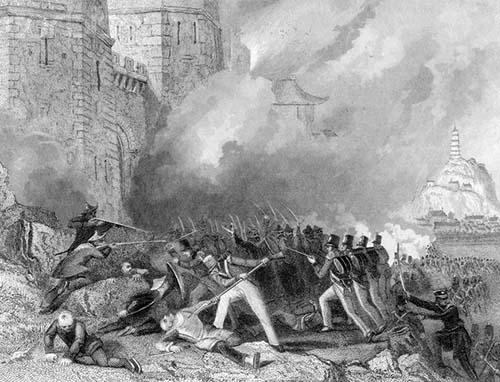 Liberalism is the theory of the strongest, or in any case of those who in particular conditions take advantage of free trade (like the states that will give life to the Confederation), so much so that in history, on more than one occasion, certain markets have been open to cannon fire and in some cases to guarantee a type of free trade that is not really edifying. For example, England has twice waged war on China (in 1839 and 1856) to be able to trade freely opium in the Middle Empire.
Liberalism is the theory of the strongest, or in any case of those who in particular conditions take advantage of free trade (like the states that will give life to the Confederation), so much so that in history, on more than one occasion, certain markets have been open to cannon fire and in some cases to guarantee a type of free trade that is not really edifying. For example, England has twice waged war on China (in 1839 and 1856) to be able to trade freely opium in the Middle Empire.
In spite of the formulations of an abstract liberalism, the state powers have always been, and remain, tools of the struggle for competition between economic groups and are even more so in a sector such as defense. In this sense, the history of the United States is certainly no exception, in case the peculiarity of the American canvas lies in the dimension taken by these tools.
Among the factors that have enabled the US to become the first world power, it fully represents the capacity for political centralization of a state that - even with the physiological frictions and compromises that characterize the synthesis path of a general interest, made even more complex from a federal institutional architecture - it contributed decisively to the formation, development and management of an internal market and an economic-industrial apparatus of continental dimensions.
The latter will be the dimension of power to establish itself in the fire of the Second World War: even if the representation of a world divided between only two "superpowers" was a hoax, the fact remains that the world order formalized in Yalta was based mainly on state of power relations between the United States and the Soviet Union, two major continental powers.
From the second post-war period to be able to at least aspire (since then an effective exercise is another thing), to a role of global leadership, the continental tonnage had become an unassailable prerequisite. The historical sense and the strategic content of the European unification process reside in this scale-up in the relations between powers, which not by chance took its first steps in the 50 years.

Today that requirement has become more stringent with the entry on the international chessboard of competitors - primarily from Asia, secondly from Latin America and in perspective, albeit with some more "problems" from Africa - which, despite the uncertainties linked to the slowdown in growth rates and not infrequently to political instability, they have a population that is counted in hundreds of millions and a GDP that in the meantime has become not negligible, as well as their domestic market.
In the context of the international relations of the 21st century, it is unrealistic to think that we can face - especially if we aspire to a role, if not a leader, at least as a co-protagonist - the global challenges that are announced, and that are already in progress, from the perspective of a state of 60-70 million inhabitants.
This is true both in the economic and political spheres, and in the military, regardless of whether one refers to international terrorism, low intensity conflicts, conventional warfare or the armaments market to be guaranteed to its own groups of defense industry.
This is an aspect that it is good not to lose sight of in the (remaining) members of the EU and with which it will soon be necessary to measure the easy enthusiasm of a self-styled neo-independence from across the Channel. If only for the fact that by now it has long been that China is no longer the time of the Opium wars or the Boxers revolt.
(photo: Office of War Information Collection / US Air Force / NASA / US Navy / Xinhua)












